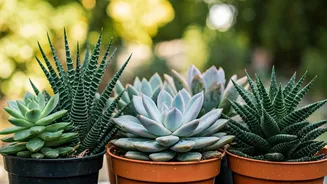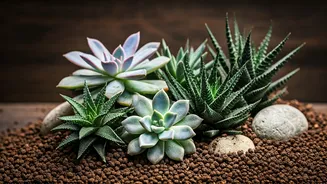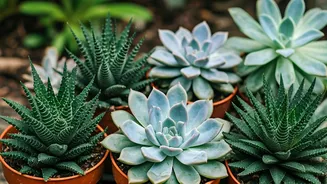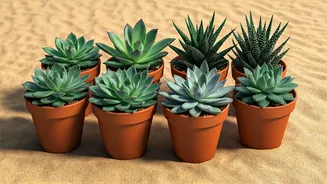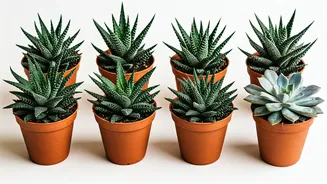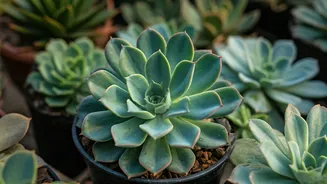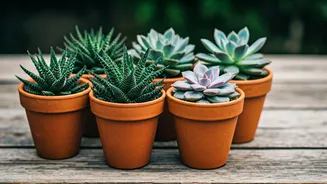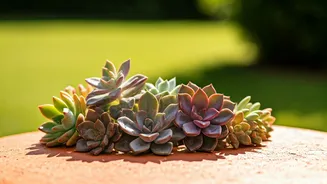Introduction to Succulents
Succulents, known for their ability to store water in their leaves, stems, or roots, are a diverse group of plants ideal for various climates. Their resilience
makes them a popular choice for both novice and experienced gardeners. Many succulents are easy to care for and can tolerate drought conditions, requiring minimal watering. This ability stems from their adaptation to arid environments. The longevity of succulents, in particular, adds to their appeal, with some species capable of surviving for decades, even centuries, with the right care. This article highlights six such examples, offering a glimpse into the world of these enduring plants and how to grow them.
Sempervivum (Houseleeks)
Sempervivum, often called houseleeks or hen and chicks, are celebrated for their rosette-shaped leaves and ability to thrive in harsh conditions. These succulents are named for their ability to survive in various environments. They're capable of living for many years, even decades, provided they are in well-draining soil and receive adequate sunlight. The 'hen and chicks' nickname comes from their growth pattern, where a mother plant (the 'hen') produces smaller offshoots (the 'chicks'). Varieties come in various colors, adding visual interest to any garden. They are relatively easy to propagate, further enhancing their appeal to gardeners. The key to their long life is proper drainage to prevent root rot, as well as plenty of sun exposure, making them ideal for rock gardens or containers.
Echeveria Elegans
Echeveria Elegans, also called Mexican Snowball, is another striking succulent that can grace gardens for a long time with proper care. These succulents are characterized by their tightly packed, symmetrical rosette formations and powdery, pale green leaves. They require well-draining soil and benefit from bright, indirect sunlight, though they can tolerate some direct sun. Echeverias typically have a life span that can extend for many years, with some varieties living for several decades if their needs are met. Regular watering is important, especially during the growing season. However, avoid overwatering, as this can lead to root rot. They are relatively easy to propagate from leaf cuttings, which makes them a popular choice among succulent enthusiasts looking to expand their collection.
Aloe Vera’s Durability
Aloe Vera, known for its medicinal properties, is a durable succulent that can thrive for an extended period. Native to arid climates, aloe vera is highly adaptable and requires little maintenance once established. These plants are known for their fleshy leaves, which contain a gel widely used for soothing skin irritations. They prefer bright, indirect light and well-draining soil. Their lifespan is typically measured in years, often several decades, provided they have the correct conditions. Aloe vera plants can be grown indoors or outdoors in warmer climates, offering versatility. Propagation of aloe vera is simple, often achieved through the separation of offshoots (pups) from the main plant. Its resilience and usefulness make it a popular addition to both gardens and households worldwide.
Agave’s Long Life
Agave plants, a diverse genus of succulents, are known for their impressive size and longevity, with some species living for decades. Agaves are native to the Americas and thrive in arid environments. They are recognizable for their spiky leaves that often form large rosettes. These plants require full sun and well-draining soil to thrive. While many agave species have a relatively long lifespan of several years, some varieties can live for several decades, with some even reaching a century. Most agaves are monocarpic, meaning they flower only once in their lifetime, then they die after producing a massive flower stalk. However, they usually produce offshoots before flowering, ensuring the continuation of the plant. Their sculptural form and resilience make them sought-after in landscaping.
Sedum (Stonecrop) Varieties
Sedum, or stonecrop, is a vast genus of succulents offering a wide array of forms, sizes, and colors. These plants are known for their hardiness and ability to thrive in various conditions. Sedums generally prefer full sun and well-draining soil. Their resilience makes them low-maintenance, easy to care for additions to any garden. Many sedum varieties can live for multiple years, and some species, such as the ground cover types, can persist for a very long period. Their ability to store water in their leaves and stems makes them drought-tolerant. Sedums come in various forms, from low-growing ground covers to taller, upright varieties, increasing their versatility. They propagate easily through stem cuttings or division, making them accessible to gardeners of all experience levels.
